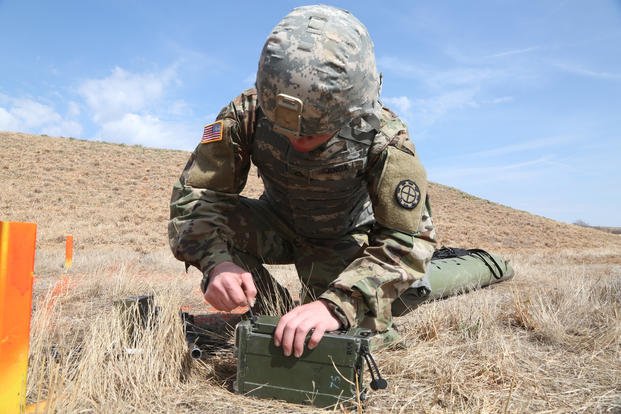The Army general in charge of fielding new combat gear outlined his vision Tuesday for an advanced digital soldier ensemble designed to eliminate all AA battery-powered weapons and tactical accessories, as well as cumbersome connecting cables, troops currently lug into battle.
Army equipment officials met with defense firms Tuesday at an industry day focusing on Adaptive Squad Architecture (ASA), a new framework to help the service and defense companies create streamlined digital, wireless gear aimed at making soldiers in close-combat squads significantly more effective in the future.
If all goes well, this evolving concept will result in equipment sets that can run communication, navigation and weapons accessories off of a common power source while significantly reducing soldier load, said Brig. Gen. Anthony Potts, commander of Program Executive Office Soldier.
Currently, soldiers in an infantry squad can carry an average of 122 pounds of kit, made up of combinations of roughly 85 separate pieces of equipment, Potts said, describing how weapons optics, aiming lights, weapon lights, night vision, radios and other gear are all powered by redundant power sources such as AA and other small batteries.
"I don't want AA batteries; I don't want all kinds of other battery power sources because, from my perspective for a soldier, all that means is it's another logistics supply need that has to be fed," he said.
Potts also wants to replace the bulky connecting cables, used to connect radios and situational awareness gear to power sources, with wireless interfaces.
"All these cables, I want to get rid of them," he said. "I don't know how realistic that is, but it doesn't mean I don't want to try. We don't want things that are snag hazards on soldiers. We don't want soldiers to have to be creative about how to route every single cable they have got on their body."
The Adaptive Squad Architecture effort is part of the soldier lethality priority in the Army's bold modernization strategy.
The need for this new framework grew out of the service's effort to develop the new Integrated Visual Augmentation System, or IVAS, a Microsoft technology that Army officials say will allow soldiers to see their weapons reticle and other tactical information through a pair of tactical glasses. The high-tech system will also run augmented reality to allow soldiers to conduct realistic virtual training without leaving home station.
"We knew because [of] the scope of what we were trying to put together for IVAS that we needed something bigger than just component-level configuration management," Potts told reporters at the event. "ASA actually reflects the IVAS interface as we build it."
But this new framework can't succeed without a new level of involvement from the defense industry, he said.
"Here is what I will promise you: Right out of the gate, we will get this wrong," Potts said. "This is where I need your help. Tell me how to make it right. … But if you tell us nothing, if you are not engaged with us, if you are not giving us your feedback -- we are not going to be able to make this work."
The Army is expected to release in January what it calls "problem statements" for industry as a prompt to find new approaches to challenges such as soldier power needs, data sharing and body armor, as well as improving how intra-soldier wireless equipment operates within the squad. The first responses are scheduled to be due back to the Army in March, officials said.
Meanwhile, IVAS is scheduled to be fielded in the fourth quarter of fiscal 2021, according to Potts.
Despite the challenges facing them, Army equipment officials seem confident, pointing to plans to field what is really the first example of a very basic ASA capability to an armored brigade combat team in September with the new Enhanced Night Vision Goggle-B (ENVG-B) and the Family of Weapon Sight-Individual (FWS-I).
Soldiers can wirelessly transmit the FSW-I's sight reticle into the ENVG-B to create rapid target acquisition in both day or night settings, equipment officials said.
While it's unclear when the new framework will start putting this advanced kit into soldiers' hands, Potts said having a fully digitized architecture will make the squad far more lethal than it is today.
"A squad may not always have the firepower to deal with an obstacle that's in front of it, but ... if you have something like your next-generation fire control that's on the Next Generation Squad Weapon, you can see it, you can lase it, you can target it," he said, referring to the NGSW, a 6.8mm weapon system the Army is developing to replace the M249 squad automatic weapon and the M4A1 carbine.
"The ability to share that data, that information based off of the digital architecture, share it with ... an [AH-64] Apache that's coming in overhead and the targeting data goes to his information center. And now you can have the right capability to take out that [enemy] platform without exposing yourself just because, in this architecture, we can share in near-real time. That's what I think makes the squad more powerful," Potts said.
-- Matthew Cox can be reached at matthew.cox@military.com.













